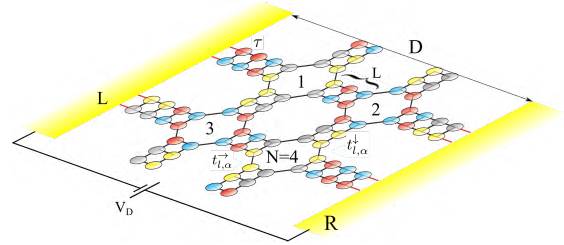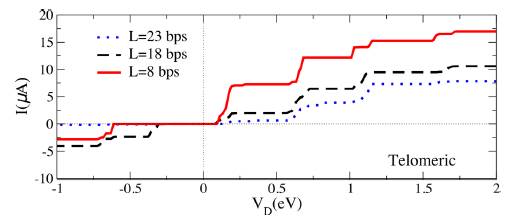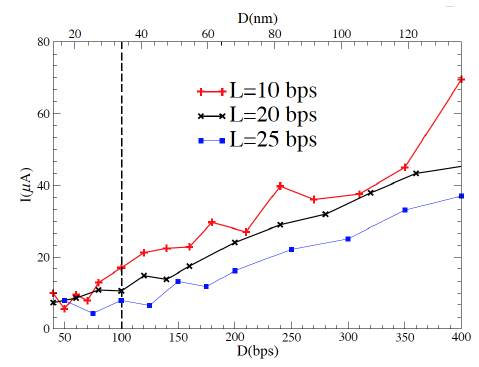INTRODUCTION
Today, there is an increasing interest in nanotechnology based in DNA, especially, after Seeman's works [1, 2]. Seeman converted the DNA molecule (unidimensional structure) into 2D and 3D complex asymmetric structures named self-assembled DNA, where single strands of DNA were hybridized to form stable crosses. This self-arrangement of branched artificial DNA is useful for designing and constructing electronic nanodevices [3 - 8] for its high nanoscale precision [9-11]. The self-assembled DNA has an accuracy at the nanoscale regime, i. e., a much higher resolution than conventional lithography.
The electronic and transport properties of self-assembled DNA remain unexplored. Thus, as the electronic properties of electronic nanodevices based in the self-assembled DNA depend on their structural features [12-14], the study of these electronic and transport properties may become essential. Here, we contribute to the discussion by studying the electrical transport across of a self-assembled telomeric DNA: A real, simple, and periodic DNA sequence, rich in Guanine base pairs (TTAGGG) [15, 16].
1. THEORETICAL FORMULATION
In this study, we describe the transport properties of a self-assembled DNA molecule according to an heuristic tight-binding model where the self-assembled DNA molecule is coupled to two electrodes (right - R, and left - L), as shown in figure 1.

Source: Prepared by the authors.
Figure 1 Schematic representation of a ladder-type model for electronic transport along self-assembled telomeric DNA between two semi-infinite source (L) and drain (R) contacts, as indicated
The nucleotide base pairs sequence is indicated in figure 1 by circles, representing the four possible effective nucleotides. Different colors indicate different nucleotides: A (Red), T (blue), C (yellow) and G (gray). The possible electronic pathways are shown as lines.
We use a simple double chain model [17-19], where we take the correlation between pyrimidines (C, T) and purines (A, G) through base to base hopping terms. Thus, the Hamiltonian can be written as described in equation (1).
Here, N is the total number of base pairs (bps) in the two-dimensional self-assembled DNA, a corresponds to the specific base pair that completes the correlation, and εla are the effective primary ionization energies of the base nucleotides, i. e., εA = 8.24 eV for adenine, εT = 9.14 eV for thymine, εC = 8.87 eV for cytosine and εG = 7.75 eV for guanine. The base to base couplings are t' = 0.35 eV between identical bases and t' = 0.17 eV among different bases. Perpendicular couplings between pyrimidines or purines are t = 0.7 eV. The choice of these parameters depends on the type of DNA, and its interaction with the environment. Environmental characteristics influence the load migration properties [20].
The transmission probability T(E) between the electrodes can be evaluated by equation (2):
Where ΓL(R) = i (ΣL(R) - ΣL(R)) is the broadening function, and is related to the lifetimes of electron in the systems. G r is the retarded Green's function of the system which can be found from [21], according to equation (3).
Here, E is a diagonal matrix, and Σ l (R) = TL † (R) g L , R T L (r ) are the self-energies for the source (left) and drain (right) contacts, respectively. The contact Green's function g, in this case, a square lattice, was numerically estimated by using a recursive technique [22]. The electrode-molecule coupling t is determined by the geometry of the chemical bond. We use a constant coupling t = 0.35 eV of similar magnitude as the inter-chain DNA couplings [23].
The current-voltage characteristic can be expressed as [24] shown in equation (4):
Where the Fermi levels in source and drain are μ L and μ R = V D + μ L , respectively. VD is the voltage applied between the contacts. The use of this model has grown in interest in the last decade [23] because, despite the simplified mathematics structure, it allows to study the electronic and transport properties of systems with more than 10,000 sites in contradistinction to ab-initio approaches.
2. RESULTS AND DISCUSSION
As it has been demonstrated, the transport of electrons through self-assembled DNA occurs by quantum tunneling. Thus, order or disorder in the structure play an important role in the characterization of these devices. Based on previous studies of transport in simple molecules [15], we studied the charge transport across an orderly self-assembled telomeric DNA. The telomeric sequence combines the advantages of a simple periodic structure with the richness and biological function of a real DNA sequence. Figure 2 shows the characteristic current-voltage I-V, behavior of a telomeric self-assembled DNA system, consisting of four horizontal chains and four vertical chains separated by 8 bps (red curve), 18 pbs (black curve), and 23 pbs (green curve).

Source: Prepared by the authors.
Figure 2 I-V characteristics for self-assembled telomeric DNA with different leg lengths (L = 8 bps [red], L = 28 bps [black], and L = 98 bps [blue]) for a fixed number of crosses N = 4
The plateaus in the I-V characteristics are associated with gaps in the transmission spectrum. The increase in the two-dimensionality of the system introduced more plateaus in the I-V characteristic. This effect is caused by the increase in the number of transmission channels, which depends on the number of horizontal DNA chains linked to the contacts. Figure 2 shows that the robust effect of the plateaus on the I-V characteristic, common to the telomeric sequence, is conserved [15]. In the telomeric case, the wave function is delocalized over the entire system. For any energy, the electronic probability is higher near the contacts, and decreases towards the center of the system as the number of vertical chains is increased. An important feature is emphasized: In self-assembled telomeric DNA by increasing two-dimensionality, that is, the number of horizontal and vertical chains, the saturation current is increased. Two-dimensional DNA models offer the opportunity to construct materials with nanometric precision, allowing them to be considered as possible components of functional devices. However, the main difficulty lies in its characterization.
Figure 3 shows the effect of the size (D) of the auto-arrangement (square mesh) and the separation (L) between the chains that make the auto-arrangement over the current. The red curve represents a system with L = 10 bps; the black curve is a system with L = 20 bps, and the blue curve is a system with L = 25 bps.

Source: Prepared by the authors.
Figure 3 The current I as a function of length D at VD = 1.5 eV for telomeric at chains separations L=10, L=20, and L=30 base pairs
For the telomeric case, regardless of the separation L, at a voltage VD = 2 eV, the current increases with increasing size D. For any size D, decreasing the separation L increases the current, due to an increase in the degree of relocation of the electronic states. We assumed that the coupled between the self-assembled telomeric DNA and the contacts is similar to a coupled between base-base pair. The DNA-contact bond can influence the I-V characteristic. Thus, we used a metallic contact. For the telomeric case, given a number of channels, if the separation between the chains (L) increases, the current is increased. Our main contribution is to identify self-assembled telomeric DNA as candidates for the construction of 2D nanodevices such as DNA Origami, as it is possible to make more structured self-arrangements without drastically decreasing current. Although the structures shown here are simple, their study should be the first step to denote more complex DNA devices, which could be used in a wide variety of circuits.
3. CONCLUSIONS
A study on the transport properties of self-assembled DNA using Green's function method was presented here. The self-assembled telomeric DNA that was the subject of this work provides a reference for the systematic investigation of possible DNA applications in nanoelectronics.
We present results on transport properties in the self-assembled Telomeric DNA system. I-V characteristic spectrum shows an increase of current with increasing systems size and a set of plateaus in the I-V characteristics, associated with gaps in the transmission spectrum, so the current is quantized. The increase in the two-dimensionality of the system introduced more plateaus in the I-V characteristic. This effect is caused by the increase in the number of transmission channels, which depend on the number of horizontal DNA chains linked to the contacts.



















